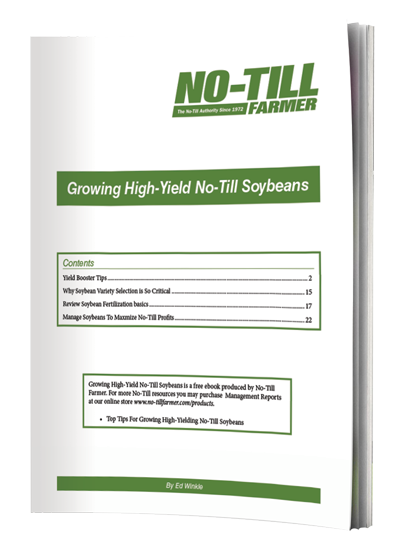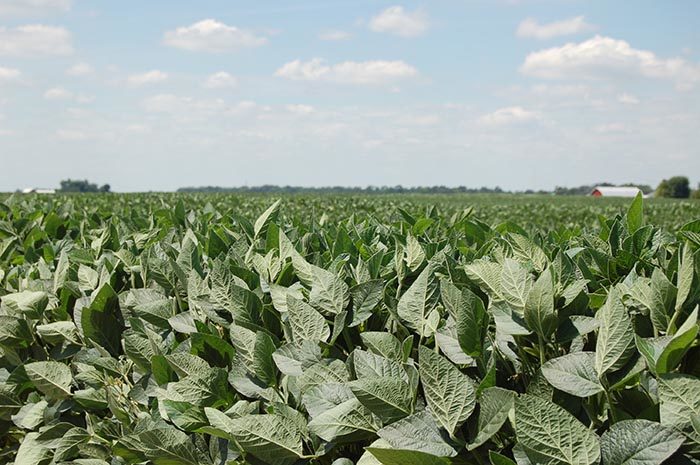
Dear No-Till Farmer,
When the topic of high yields comes up, corn is typically the first crop that comes to mind. But that doesn’t mean it’ll make you the most money. In fact, University of Illinois reported that in recent years, soybeans have been more profitable than corn in the state.
Trying to grow higher no-till soybean yields may not be easy, but if you find new ways to improve soil fertility, manage pests and diseases, and plant soybeans at the right seeding rate, then higher yields — and profits — are within your reach.
To help you overcome the challenges of increasing your no-till soybean yields, we’ve compiled an eGuide download on what you need to know — and we’ve made it absolutely FREE, so you can watch your soybeans make the best yields you’ve ever had.
Valuable tips on growing high-yielding soybeans, compiled by the most trusted name in no-till.
This 21-page eGuide, valued at $11.95, provides what you need to know to produce more soybeans per acre, all in one reader-friendly report. It includes the best planting dates, seeding rates and seed treatments for high-yielding no-till soybeans. It’s a report you’ll turn to again and again as you plant, fertilize and protect the valuable soybeans in your no-till operation. Keep it handy as a primer prior to heading into your soybean fields!
Growing High-Yield No-Till Soybeans is a comprehensive, actionable reference to help you no-till the most bushels per acre. In fact, this eGuide is designed to help you…
- Learn the 19 tips that will help you achieve higher-yielding no-till soybeans.
- Understand why variety selection is so critical and how to choose the varieties that will maximize your returns.
- Review the 8 components that are critical for highly efficient soybean fertility.
- Recognize the pests and diseases that pose a threat to soybeans, how to prevent them and most effectively combat them.
- Start perfecting your no-till soybean program so you can watch your soybean yields steadily increase.
There’s a common perception that soybean yields have reached a plateau. Perhaps the only reason you’re growing soybeans is for the crop rotation benefits. But we know the cost of raising soybeans isn’t nearly as much as corn, and focusing on better soybean yields may provide better profits. Consider this:
- You can expect a yield increase of 2 to 7 bushels per acre just by adding an inoculant to your soybean seed.
- Pre-plant control of weeds can boost no-till soybean yields by 4 to 7 bushels per acre.
We know your time is money. But if you did nothing more than read how to protect your soybeans in this FREE eGuide, you’d already be significantly ahead.
No-Till Farmer is dedicated to helping progressive no-tillers improve their operations. Did you know…
10 Tips for Higher Soybean Yields
Would you be surprised to know your planting dates may be a barrier to producing better soybean yields? Here are some other facts that influence soybean yields:
- Fields with no prior soybean history may benefit from additional nitrogen if soil-test results indicate there’s less than 60 pounds per acre available in the top 24 inches.
- Seed handling damage is the greatest single cause of poor soybean germination and low seedling vigor.
- Planting in 30-inch rows may be beneficial in drier regions.
- Full-season varieties should be favored over early varieties for late-season plantings.
- A soil pH below 6.0 will likely decrease soybean yields due to molybdenum deficiency, reduced nodulation and nitrogen fixation.
- Banded fertilizer applications should be placed 2 inches to the side and 2 inches below the seed.
- Narrowing your rows down to 7.5 to 15 inches produce the highest yields and best weed suppression.
- Even if you see no evidence of disease, seed-applied fungicide can still increase your yields by 1.6 bushels per acre.
- Planting deeper than 2 inches may lead to poor emergence.
- Weed control the first 2-4 weeks of the growing season is essential to maximizing your yields.
To learn more about these tips and how to implement them on your own farm, read our FREE eGuide, Growing High-Yield No-Till Soybeans.
Advice straight from agronomists and top-notch experts
This eGuide lays out the foundation for getting your no-till soybeans off to a great start, protecting them from pests and diseases, and harvesting the best yields you’ve ever had. The eGuide also shares soybean fertility tips and practices, and how to select the right varieties. Keep it handy when developing your no-till soybean management program.
That’s the kind of actionable information you get throughout this FREE eGuide —presented in clear, straightforward language, with easy to follow management instructions.
But you get more than just tips and facts; you’ll gain insight about what influences soybean health and what to tweak for optimum yields in your conditions. You’ll get valuable insights on:
- Planting widths — narrow vs. wide rows
- Soybean maturities
- Macro- and micronutrient requirements
- Seeding rates
- Best harvesting practices to put more beans in the bin.
For every question, you’ll improve your management for no-till soybeans, while learning how to grow even higher yields.
Read this free eGuide right now to learn how to make this important topic a #1 directive for you this year.
Takeaways to develop your no-till soybean program — and incorporate new management strategies
In addition to the wealth of information this in-depth eGuide delivers, it also provides actionable takeaways that you can use today:
- Harvest when mature soybean plants contain 14% moisture.
- Aim for a seeding rate of 175,000 seeds per acre in a 12- to 15-inch row spacing, and 200,000 seeds per acre when solid-seeding in 6- to 8-inch rows.
- Use only seed that was produced the previous crop year, as older soybean seed usually has lower germination and reduced seedling vigor.
These are just some of the takeaways you’ll find by downloading this free eGuide and reviewing it with your morning coffee.
Here are a few more...
- When soybean plants and pods are tough, your combine’s cylinder speed may need to be increased.
- Match tall soybeans to upland areas of fields and no-till shorter beans in lowland areas to avoid lodging.
- Ideal reel speed for soybean harvest is 25% faster than your ground speed.
- The critical time for making soybean aphid treatment decisions based on population levels occurs during the late vegetative to early reproductive stages.
And that’s just the tip of the iceberg. Keep some of the findings in this eGuide at the top of your mind and you’ll be ready for a higher income in your soybean season.
By now I’m sure you see the value of this carefully prepared eGuide and what this knowledge can do for you. No one who wants to be a progressive no-tiller should overlook its value! And because you’ve taken the time to read this, you’re clearly a person who values your no-till crops and how to get the most out of them.
That means you’re exactly the kind of person we hope to reach with Growing High-Yield No-Till Soybeans. The kind of “in-the-know” farmer who plans on improving their soybean yields — and profits — for years to come.
Whether you just grow soybeans as part of an essential crop rotation or have been experimenting and boosting your no-till soybean yields for years, what better way to move forward than with this comprehensive, authoritative — FREE — eGuide?
- Do you want to stay one step ahead of your no-till peers?
- Are you prepared to adapt to a changing ag economy and meet the demand for higher yields and profits?
- Do you know how to produce more bushels from your no-till soybean fields?
Then download this free eGuide right now, and get started. The minute you do, you start the clock ticking toward producing greater soybean yields.
Yours for better no-tilling,
Laura Barrera
Managing Editor
No-Till Farmer * Conservation Tillage Guide * No-Till Insider
PS: What are the most common soybean-yield robbers to look out for? Find out by downloading Growing High-Yield No-Till Soybeans right now.
PSS: There are several practices and ideas you can implement for better no-till soybean yields. You can start watching the number on your yield monitor climb this fall by reading this FREE eGuide now.
What new insights did you gain from this eGuide? What jumped out at you?
Share your observations below.




Post a comment
Report Abusive Comment